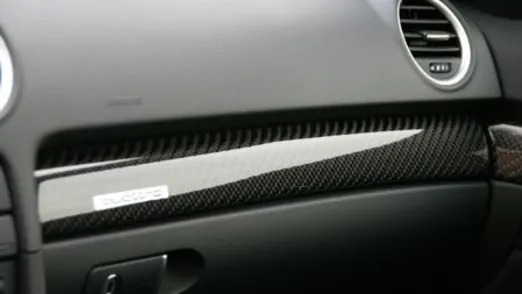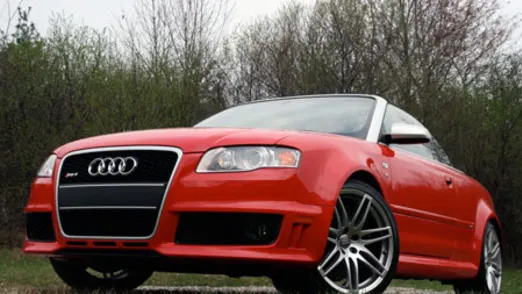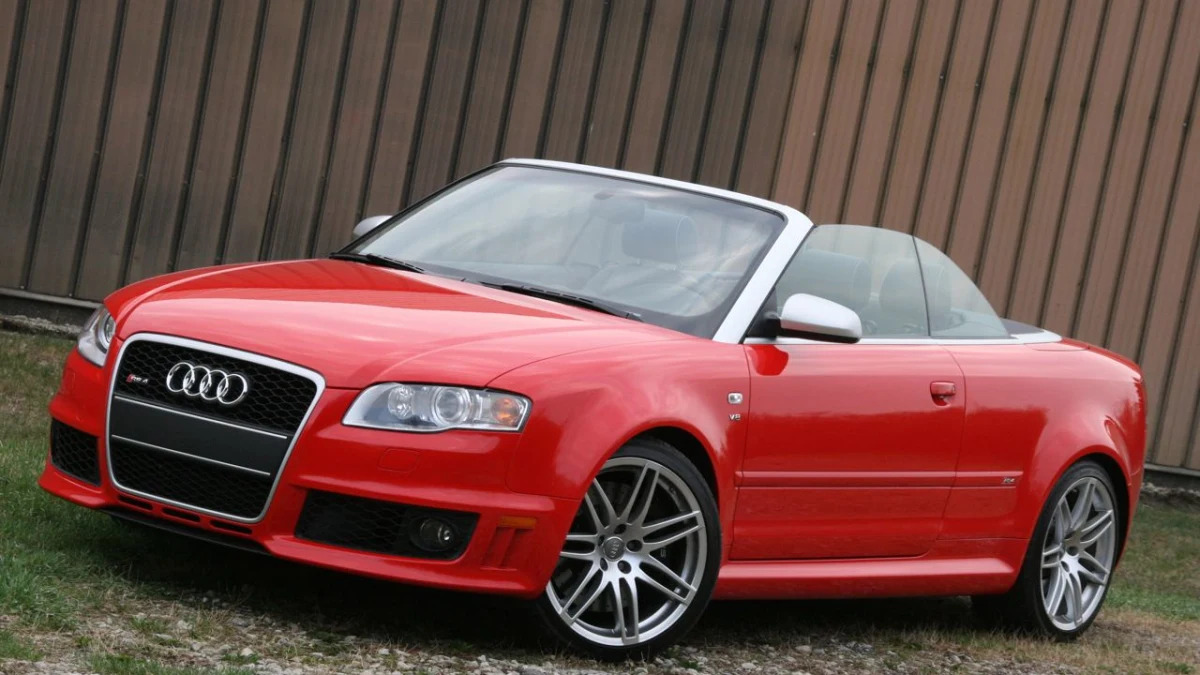Audi RS4 Cabriolet – Click above for high-res image gallery
Just about the time that a Misano Red 2008 Audi RS4 Cabriolet arrived in the Autoblog Garage, the very last examples of the breed were rolling off the assembly line at the Quattro GmbH facility in Neckarsulm Germany. During my trip to Germany a couple of weeks prior for the launch drive of the new Audi A4 Avant, we had an opportunity to sit down in Neckarsulm with the General Manager for Development of Quattro GmbH, Stephan Reil. Quattro is Audi's in-house tuner division, comparable to AMG for Mercedes-Benz and the M Division at BMW.
Quattro GmbH has several divisions, one of which is responsible for development and part of the production of Audi RS models such as this RS4 Cabriolet and the new RS6. Another group is responsible for all aspects of a car from development to production and quality control. The first product of this latter team is the Audi R8 that debuted last year. The third group is responsible for accessories like the S-Line products and the last department handles individualization of new cars. When customers order a new Audi, they can have it customized in innumerable ways such as custom colors, upholstery and pretty much any add-on you can think of that adds plenty to Audi's bottom line. There is also a group apart from the vehicle groups that is responsible for lifestyle products, which could be anything from umbrellas to Jeff Kuhlman's (Audi of America Communications Director) favorite, the Audi cigar cutter. Read on after the jump for my impressions of the RS4 Cabrio and to learn what Reil had to say about Quattro and how they came to build this car.
Photos Copyright ©2008 Sam Abuelsamid / Weblogs, Inc.
We had our sit-down with Reil right after our tour of the R8 factory. Audi's Neckarsulm campus includes an array of buildings in which are built mainstream models such as the A4, A5 and A6. One building is dedicated to production of the R8, and all of the RS models also get produced in Neckarsulm. Front and center of course is the Audi Forum. Both the headquarters in Ingoldstadt and the Neckarsulm campus feature a Forum that includes a public display area for both historic and current Audi models, restaurants and a shop where visitors can buy all of those aforementioned lifestyle accessories . Those who have ordered an Audi can visit the Forums to meet with a consultant who will help with any individualization planned for the car. Finally, anyone who orders an Audi, including non-Europeans, can pick it up at the Forum. North American buyers who opt to take delivery at the Forum can fly over and Audi will provide 15 days worth of European insurance so that they can drive their new car while on a European vacation. At the end of the trip, owners can just drop off the car at a shipping center and then pick it up from their local dealer after they get home.
We sat down with Reil in a conference room at the Neckarsulm Forum where he talked about Quattro's philosophy and how the cars have evolved over the years. Reil has been running vehicle development at Quattro for the past decade, and when asked how things have changed over the years he described the first RS4 relative to today's model.


"If you have a look to the past what you see is the power is increasing.The first RS4 started with 380hp and we had 420 in the next model, the old RS6 450hp and the actual new RS6 is 580hp. What you also see is that, if you drive the old RS4 and the current RS4, there is much more quality in the car, how precise the car drives, how the car handles, the driving performance on a racetrack is so much different from one car generation to the next. The improvement on handling and comfort... In the past a sporty car had a very stiff suspension, and a quite uncomfortable suspension."


I personally never had an opportunity to drive a first generation RS4. However, when I hopped into the Misano Red RS4 Cabrio, the ride quality was definitely impressive for a car with these performance capabilities. When a car is riding on 255/35ZR19 tires, the minimalist sidewalls really can't be counted on to provide any measurable compliance while traversing uneven roads.
The RS4 certainly didn't feel harsh on the roads in and around Ann Arbor, however when the roads got particularly nasty, one thing became apparent. The removal of the roof structure on the B7 generation A4 chassis does it no favors where rigidity is concerned. On the heavily patched and heaved roads around these parts, the windshield frame vibrates noticeably in directions that are out of phase with the rest of the body. By no means is it as bad as some convertibles from the late '80s and early '90s (the Mercury Capri of that era was a particularly egregious example), but for a car with 420 hp, it could certainly use a little reenforcement.

Speaking of that engine, it's the same unit that motivates the might R8. In this high-output naturally aspirated form, the 4.2L V8 is a prime example of what makes internal combustion engines so appealing. The aural symphony played by this beauty is absolutely scintillating. Putting your right foot down brings forth a roar that says in no uncertain terms that this car is not one with which to be trifled. With the fully lined and fully automatic roof retracted below the rear deck as the mill approaches its 8,000rpm red-line, vibration is virtually nonexistent, but the sound sends a chill down your spine.


The driver's work environment in the RS4 is all business, but at the same time lacks for nothing in terms of luxury. The seats offer a multitude of ways to adjust and hold you securely in front of the thick leather wrapped steering wheel. Even on a cold late April morning, the thermal enhancement of the seats keeps you comfortable when the top is down, allowing you to focus on carving corners instead of keeping warm. The also seats provide excellent support in all the right places, behind the shoulders, under the thighs and around the torso. They are ideally suited to the task at hand. Unfortunately, that lessening of structural integrity can also be felt through the helm in the form of some shake on rough pavement.
When Reil was questioned about creating more stripped down elemental cars along the lines of a 911 GT3, he responded that a few years ago they built a special version of the TT (that of course never made it to the U.S.). This "club sport" edition of the first TT coupe had the rear seat removed and replaced with a bar and a net like those put in the windows of race cars. The net was only there to keep luggage from hitting the driver under braking. It also had a lighter sport seat, no air conditioning and most of the comfort features discarded. All told it was about 200 lbs lighter than a standard TT and had 20 hp more for a total of 245 hp.

In the RS4 and RS6, weight reduction possibilities are limited because of what customers expect in this type of car. "It makes sense in a sports car like the TT and in the future maybe on an R8. An RS model has to have outstanding handling performance, the car must be able to have have good records on not just daily driving but also on a race track. All Quattro GmbH cars go through a durability test on the Nurburgring NordSchliefe for 8,000km. That's where we check the racing abilities and the durability. On an RS you also need outstanding quality on the details. That means the materials, how it's crafted..." As is typical of Audis, the RS4 has excellent interior fit and finish. The black leather seats are accented with white piping while a strip of carbon fiber traverses the dash from door to door and another piece surrounds the shifter.


Reil discussed how Quattro distinguishes Audis from its competitors like BMW M and Mercedes AMG models. "Audi has three distinct levels with standard A models like the A4, A5 and A6 with a range of engines from small to medium sized. The S models (such as the S4) are defined as the sporty versions of the A cars, and then above those we have the RS4, and this is defined as superior performance, handling and showing the technically possible. This suits very well when you compare to the competitors cars.Of course we have one thing that they don't have and this is the Quattro drivetrain."


With 420 hp, the base front-wheel-drive setup of the A4 clearly would not do in an RS. The quattro all-wheel drive does a great job of putting the power down via a 6-speed gearbox. Even with all that torque to transmit, the clutch effort is relatively light making around town motoring easy. The shift mechanism is smooth and precise making it also easy to find the right gear. Cruising around town with the top down is a pleasure, something that can't be said for the R8 with the R-Tronic transmission, but that's a story we've already told.
One issue that all European manufacturers face in the next few years is CO2 emissions limits. "The relevance of an RS model on global CO2, you can just forget it!" says Reil because of the relatively few RS cars built out of Audi's total volume and the fact that most accumulate fewer miles than mainstream models. "That doesn't mean we ignore that issue", he says, "There will be no chance to have a 500hp car with a CO2 of 140g/km, this is technically and physically impossible" (at least with internal combustion).




"What we will do is to have the most efficient engine, the most efficient drivetrain, the most efficient car that is possible at that time." With the new RS6, Audi has a 130-hp increase in power along with 100Nm more torque and fuel consumption that is reduced by 15 percent compared to the previous generation. In absolute terms of course, all high performance cars get comparatively poor fuel economy. However, when comparing specific fuel consumption, they have improved dramatically over the past few decades and any time you can get more from less, it will ultimately help performance, too.
Reil also discussed with us the difference in philosophy between Quattro and AMG. In recent years, AMG has installed basically the same 6.3L V8 engine in almost very Mercedes car, which can cause confusion about which is the flagship. From a performance standpoint, if you put the same engine in several cars, the smallest and lightest will be the fastest. In the case of the C63 AMG, it's also the cheapest.

Instead, according to Reil, "Our philosophy is to develop the whole package in that car line, for what the customers expect, what is the right thing that we would see in that category. This is the reason why we are driving in the RS4, a V8 high-rev, naturally aspirated engine, because in a small light car, you can position that car louder, I mean louder not by noise, but louder by positioning the car. It can look a little more extreme, it can perform a little more extreme, it can handle a little more extreme."
The acceleration of the RS4 definitely matches up with this positioning. Even though as a convertible the example I drove was heavier and less rigid than the sedan that Alex reviewed a few weeks ago, it was very fast and tracked through corners precisely. The RS4 cabriolet managed about 15 mpg during its time in our garage, which is nothing to write home about. Not spectacular, but then again, if you can swing $85,000 for this beast you probably won't care, and relative to some other machines capable of launching to 60 mph in the mid 4-second range, it's actually pretty good. For those looking for maximum performance with room for four, the sedan may be the better option. For those looking to show off with only a slightly less sharp edge, the RS4 Cabriolet is a great way to go. And only with the top down can you truly appreciate that glorious sound! We can't what to see what the team at Quattro devise for the next version.

Photos Copyright ©2008 Sam Abuelsamid / Weblogs, Inc.
Our travel and lodging for this media event was provided by the manufacturer.




Sign in to post
Please sign in to leave a comment.
Continue